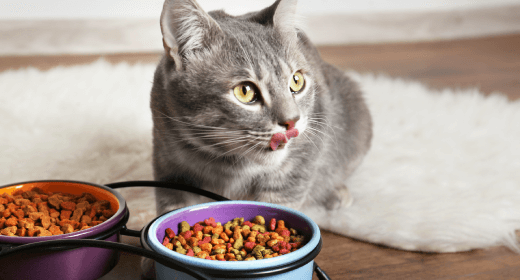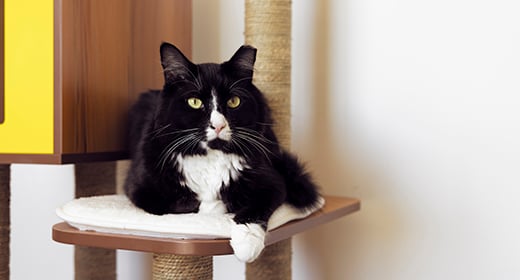

Good nutrition is as important to your cat as it is to you, but her nutritional needs are quite different! Unlike humans, a cat needs a high-fat diet with less fibre. Even if you prefer a vegetarian diet, you should understand that cats are carnivores. They need nutrients from animal protein and fat for optimal health, and they benefit from fibre for a healthy digestive tract and carbohydrates for energy.
With thousands of pet foods available, how do you pick the one that's right for your cat?
Start by identifying the cat's life stage and lifestyle. Kittens, nursing mothers, and mature/senior pets are examples of life stages, and each has different nutritional requirements. All cat foods should state which life stage they are recommended for.
Nutritional needs also vary depending on lifestyle. A cat whose primary activity is guarding the couch doesn't need as much energy as one who likes to spend time roaming outside.
Finally, it is important to take into account any special medical condition your cat may have, including food allergies that might require a special diet recommended by your veterinarian.
Once you've determined your cat's life stage and lifestyle needs, decide whether to feed dry or wet food. Most cats thrive on only dry food. This type of food promotes oral hygiene and health through abrasive action. Some cats, especially finicky eaters, enjoy the smooth and wet texture of canned or pouch foods.
Remember that, while dry food can be left in a bowl all day, wet food should be thrown away after 30 minutes if not eaten. Dry food is the best choice for busy people who are not normally home during the day.
Once you know your pet's nutritional needs and your pet's preference, you are ready to go shopping.
Because cats need the nutrients found in animal sources, it’s best to pick a food in which a primary ingredient (one of the first ones listed) is an animal-based protein source such as chicken, lamb, fish, egg, or one of their by-products. These ingredients contain all the essential amino acids, including taurine, which isn’t found in a vegetable-based protein source.
Using a combination of carbohydrates in a diet, such as corn meal or barley and grain sorghum, ensures efficient absorption and helps maintain energy levels. And beet pulp is an excellent fibre source that promotes a healthy digestive tract.
For a soft, thick coat and healthy skin, your pet needs fatty acids like those found in vitamin-rich fish oils and quality fat sources such as chicken.
Cat food labels provide limited information on the nutritional value of your pet's food because labeling regulations do not allow manufacturers to describe the quality of ingredients on the package. A reputable pet food manufacturer can explain to you how they evaluate and assure the quality of their products.
When choosing food, the price on the bag, while important, is usually not the best consideration. A low price may indicate cheap ingredients, or ingredients that change as manufacturer costs fluctuate.
In addition, many lower-priced products have higher daily portions to provide the same amount of nutrition found in a high-quality diet. To get a better idea of cost, it is the cost per feeding, not the total cost, that counts.
To figure cost per feeding, divide the total cost by the number of days the product lasts. For example, a 20-lb bag of food that costs $18.99 and lasts 30 days is $0.63 per day. A 20-lb bag that costs $15.99 and lasts 20 days costs $0.80 per day. When compared closely, high-quality pet foods are quite favourable to other brands.


Cats are generally considered to be low-maintenance pets. However, that’s nothing but a myth. You need to care for a cat the way you would care for any baby, especially with regards to its health and overall well-being. Although medical treatments are available for most feline illnesses, prevention is always better than cure. Cat vaccinations, such as the anti-rabies and FVRCP vaccine, protect your furry friends from deadly infections like rabies. But did you know? These diseases are transmissible to humans as well. Yes. So, when you vaccinate your cat against such medical conditions, you also reduce the possibility of contracting fatal diseases from your own pet.
Feline vaccines are scientifically developed to boost the cat’s immunity and fight fatal diseases. Even though there is no ‘one size fits all’ protocol for immunization, veterinarians suggest cat injections depending on your pet’s age, overall health, lifestyle, and breed. Moreover, these vaccinations are primarily divided into two categories – core vaccines and lifestyle vaccines. Core vaccines are essential for every cat irrespective of their lifestyle, breed, and region. Lifestyle vaccines are given to cats after considering certain circumstances.
Administering rabies and other precautionary vaccines from a young age protects cats from falling prey to serious diseases. Mentioned below are essential cat vaccinations that every kitty must get:
These are anti-rabies vaccines for cats. They are given annually or once in 3 years – depending on the type of vaccine you choose – to protect your kitty from the fatal rabies virus. While this disease is fatal for your feline friend, it can also prove terminal for humans. Rabies often spreads through bites or scratches of infected animals. And rabies patients develop signs of aggression, disorientation, and hydrophobia post incubation stage. If not treated in time, rabies often results in fatal consequences for both animals and humans. Hence, anti-rabies vaccines for cats are a must from a young age.
These are 3-in-1 vaccine for cats. FVRCP vaccine prevents cats from three different viruses – feline rhinotracheitis virus, calicivirus, and feline panleukopenia virus. Instead of getting the kitten inoculated three times, you can simply get the FVRCP vaccine. This 3-in-1 vaccine for cats is recommended annually to protect them from highly infectious diseases.
Protect your kitty from leukemia virus by getting them vaccinated. This disease can spread through body fluids like urine, saliva, and feces; hence, FeLV infects cats while grooming or sharing a bowl with an infected cat. This fatal virus can process into various associated conditions such as anemia, lymphoma, or immunosuppression. Hence, the FeLV vaccine is recommended for cats from a very young age. This vaccine consists of two doses spaced three to four weeks apart for kittens and is followed by revaccination a year later for adult cats.
An FPV vaccine also protects your cat from feline panleukopenia. Kittens should receive an FPV shot once they turn 6-8 weeks old. You should also revaccinate your four-legged angel every three to four weeks until the age of 16 weeks. After this, a booster dose should be given between the ages of 1 to 2 years.
Developed to combat 4 diseases, 4-in-1 vaccine for cats protect against rhinotracheitis, calicivirus, panleukopenia, and chlamydia. These 4 in 1 cat vaccine are also called 4-way vaccines or FVRCCP. Feline chlamydia is part of the feline upper respiratory complex and an underlying cause of most early ocular infections. Hence, kittens should receive 4-in-1 vaccine for cats at the age of 8, 12, and 16 weeks, and a revaccination once they turn a year old. Cat parents are also suggested to revaccinate their kitty every 3 years to keep their purrfect pal hale and hearty.
F5 or Fevac 5 vaccines are 5-in-1 vaccine for cats that boosts your kitty’s immune system to tackle five viruses. Getting your kitty inoculated for this combination will ensure that it is safe from a range of fatal illnesses.
Vaccines are built to boost immunity and fight deadly illnesses. However, after getting vaccinated, your kitty might show mild signs of discomfort and other symptoms. These signs and symptoms are nothing but proof that its body is building a defense mechanism to defeat deadly viruses. Side effects of anti-rabies, FVRCP vaccine, or other combination vaccines for cats may include the following symptoms:
Lethargy
Loss of appetite
Vomiting
Fever
Diarrhea
Swelling and redness around the injected area
Ensuring that your feline friend is vaccinated from time to time aids in keeping them healthy and lively. Hence, every cat parent is recommended to plan a proper vaccination schedule for their fur babies.